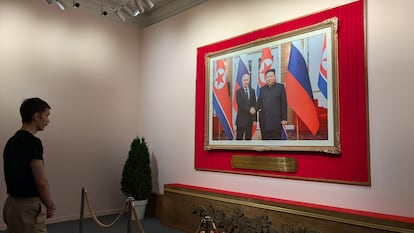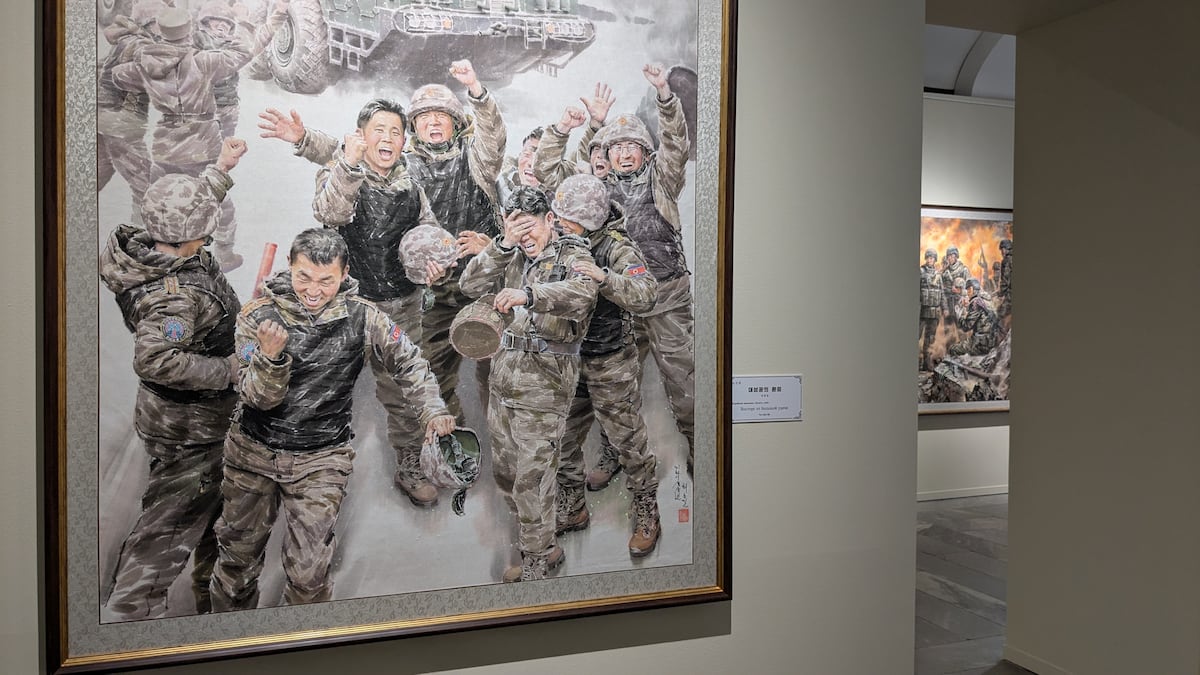For those accustomed to Russian propaganda, North Korean agitprop is a breath of fresh air in Moscow’s art galleries. The All-Russian Decorative Art Museum is currently hosting the exhibition DPRK: Country of Great People, a showcase of the arts of Moscow’s new ally in its disputes with the West. One part of the exhibition pays tribute to the participation of North Korean soldiers in the war in Ukraine, a collaboration the Kremlin initially denied. The other part shows hundreds of men and women in North Korean factories and workshops, all of them with a smile from ear to ear.
The exhibition, which runs from September 9 to October 10, reaffirms North Korea’s alliance with Russia and its attempts to emerge from ostracism. And it’s proving a success, judging by the number of visitors in the halls of the museum.
A couple stops in the entrance hallway. The man, wearing a cap with a double-headed eagle — a symbol of Moscow as the supposed spiritual successor to the Byzantine Empire, the “Third Rome” between Europe and Asia — points to a helmet in a painting. The object has a Ukrainian flag painted on it and lies upside down at the feet of a platoon of North Korean soldiers. The soldiers pose defiantly among the ruins of a burning city in Russia’s Kursk region, where the remains of a destroyed tank bear the same blue and yellow flag on its side.
The style of this and several other paintings in the exhibition resembles the War Exploits drawn by the Spanish cartoonist Boixcar during the Franco era. The only thing that has changed eight decades later are the “heroes” and the “enemy”: if in the comics of the post-war Spanish dictatorship of the 1940s and 1950s it was communism, in 21st-century Moscow it is the West.
According to Western estimates, Kim Jong-Un sent some 15,000 troops in support of Vladimir Putin a year ago after the Armed Forces of Ukraine launched a major offensive against a Russian region — Kursk — for the first time since their country was invaded in 2022. In return, Moscow provided Pyongyang with technical assistance for its nuclear program.
Virtually none of the works feature blood. The paintings don’t show mutilated troops or corpses, but rather unscathed North Korean soldiers in action, amid explosions and bullets, or celebrating victory. Only one painting, Giving a Priceless Life, offers the image of a North Korean soldier being killed in an assault on a bunker, his expression a mixture of defiance and ferocity. The man has a rifle strapped to his back. “The hero fulfills his patriotic duty by order of the Supreme Commander-in-Chief, Kim Jong-Un,” the museum’s placard explains.
“It’s not propaganda, it’s part of North Korea’s history, of its cultural heritage,” says Ilia, a recent university graduate. “It’s a true representation of what happened. It’s something worth knowing and remembering; it’s a historical monument,” he says of the collection.
A Russian soldier told this newspaper months ago that his comrades were shocked by North Korea’s martial nature: “They’re given an order and they carry it out without hesitation, even if they suffer heavy casualties. And they’re learning many lessons from the new war in Kursk,” he explained.
 A visitor at the exhibition on September 26.Javier G. Cuesta
A visitor at the exhibition on September 26.Javier G. Cuesta
Ilia’s girlfriend, Marina, an Asia specialist, also applauds the exhibition. “I like it a lot. It has a lot of bright colors, and I think it doesn’t show propaganda so much as the inner life of its people, their experiences,” she says, standing next to paintings depicting smiling, vivacious North Koreans and a Pyongyang as advanced as, or even more so than, Moscow and New York. “The cities in these paintings perhaps reflect their aspirations, their dreams,” Marina suggests.
Two young men who recently moved to Moscow from the separatist Ukrainian region of Donetsk also praised the exhibition. “These are good patriotic works,” asserts 17-year-old Artyom. “I’m going to disappoint you,” he continues. “Every country tries to show its good side. Journalists go to North Korea to show the bad, but let’s be honest and do the same with Europe.”
Artyom thinks it’s wonderful “that they show the lives of ordinary people.” “This is necessary in a context where North Korea is under so much pressure,” he adds, before explaining that the Kim regime “has China on its side, which treats it like a puppet; South Korea, which constantly provokes it; and Japan and the United States, which claim it’s a danger.”
“The only thing North Korea really has left is to demonstrate its military might,” the young man notes. In the adjacent room, countless works display dozens of North Korean artillery pieces opening fire, several fighter jets bombing an island, and missiles and rockets being launched into the sky.
An elderly woman and her grandson are featured in another painting in that same room, The Satellite of Our Happiness. The boy holds a toy tank in his hand and smiles at the news his grandmother is telling him. It concerns the launch of the Malligyong-1 spy satellite in 2023. That launch, incidentally, failed. The device ended up in the Yellow Sea, according to North Korea’s state news agency KCNA.
Strategic partnership
At the entrance to the exhibition hangs a large photo of the leaders of the Russian and North Korean regimes, Putin and Kim. The two leaders shake hands during the 2024 bilateral summit where they signed a “comprehensive strategic partnership agreement” that included a mutual defense clause. This was the same treaty that Moscow would later seal with Tehran, only to fall apart when Israel and the United States bombed Iran.
“Our countries are united by a long-standing friendship. For decades, we have provided numerous supports to our neighbor,” a guide told a group of visitors.
Official North Korean art is clearly inspired by Soviet works and emphasizes slogans that are also part of the Putin regime, such as the demand for unity around the president for a people divided between loyalists and traitors.
Next to the photo of Kim and Putin hangs another notable work in the exhibition, A Country of Unanimity and Solidarity, a painting that evokes the regime’s spectacular celebrations in Pyongyang’s Kim Il-sung Square.
“They use the square for all kinds of parades and events that require large crowds. Sometimes there are demonstrations where hundreds of people line up to register,” the guide adds, without referring to the brutal repression exercised by the North Korean regime. Under that dictatorship, strikes and protests are paid for in blood.
Sign up for our weekly newsletter to get more English-language news coverage from EL PAÍS USA Edition
